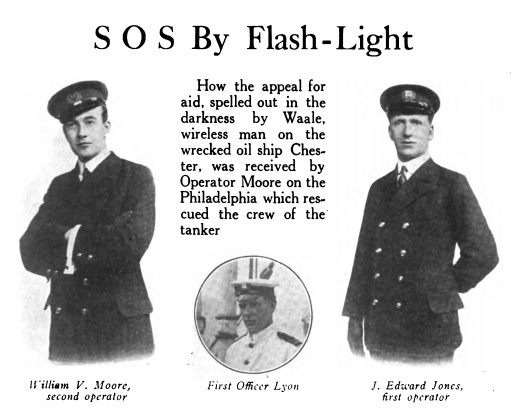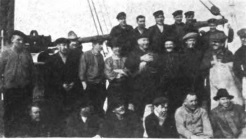The March 1915 issue of The Wireless Age carries the tale of the steamship Chester, a tanker owned by the American Petroleum Company. She had left New York on January 23 en route to Rotterdam with a cargo of oil. She ran into rough weather a few days out and suffered a tank bulkhead burst, but there was no immediate peril.
But on the afternoon of February 2, a giant wave swept over the vessel. The hatches were demolished and oil was pouring from the tanks. The engines were flooded and stopped; most of the contents of the deck, including the lifeboats were swept away; and the ship was listing so badly that the rails were in the water.
The ship was not equipped with wireless, but the second officer, Jacobus W. Waale, held a cargo grade wireless certificate and was familiar with Morse. With the one remaining signalling lamp and a flashlight, he began to signal SOS over the dark waves. All that night, no ship spotted the signal. The next day, signal flags were hoisted, also to no avail. When darkness once again fell, Waale once again resumed signalling with the lights.
Fortunately, the steamer Philadelphia was making its way from Liverpool to New York. Normally, she would have been on a more southerly route, but had moved closer to the Chester’s position in an effort to avoid storms. A tiny spark of the Chester’s light was spotted from the deck of the Philadelphia, and the officers finally realized that a ship was trying to signal them. One of the officers had some knowledge of Morse Code and made out that it was an SOS. The captain instructed the wireless operator J. Edward Jones to establish contact with the signalling ship. This, of course, was in vain, since the Chester was not equipped with wireless. The ship’s second wireless operator, William V. Moore, was summoned to the deck to make contact with the signal light.
He flashed the message, “what is the matter?” It took almost thirty minutes to receive the reply, “we are a wreck.” The Philadelphia inquired as to whether the distressed ship had any boats, to which it received a negative reply. When asked “do you want to be taken off,” the Chester replied “yes.” The rescue was not easy, but it was facilitated by the use of the lights.
Interestingly, this incident came just a few months after another notable incident involving a flashlight used to send SOS from the Hanalei recounted in an earlier post.



